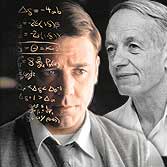The many known unknown products of John Nash’s beautiful mind
The late John Nash’s beautiful mind produced a fair number of clever concepts with compelling names. Game theory. The Nash equilibrium. Nash bargaining.
The first, of course, is the best known, for which Nash (and two others) shared the Nobel Economics Prize 21 years ago. They honed modern game theory, created by mathematician John von Neumann and economist Oskar Morgenstern into a sharp tool for economists.
But Nash bargaining is actually probably the most interesting because it is the way most of us live – and do deals – every day. As Noah Smith wrote on Bloomberg, the theory of Nash bargaining “is really just a method of bargaining that satisfies some intuitive conditions of fairness. The basic result is that a ‘fair’ bargain is one where both parties benefit equally from accepting the deal.”
That said, as Mr Smith points out Rotman School of Management economist Kevin Bryan says Nash bargaining isn’t very realistic because “in the real world, bargains aren’t fair – they depend on things such as outside options and threats.”
Apparently, game theory helps to understand what really happens in bargaining and other competitive situations.
That’s where the Nash equilibrium comes in. People make the best possible choice after considering those of the other players.


